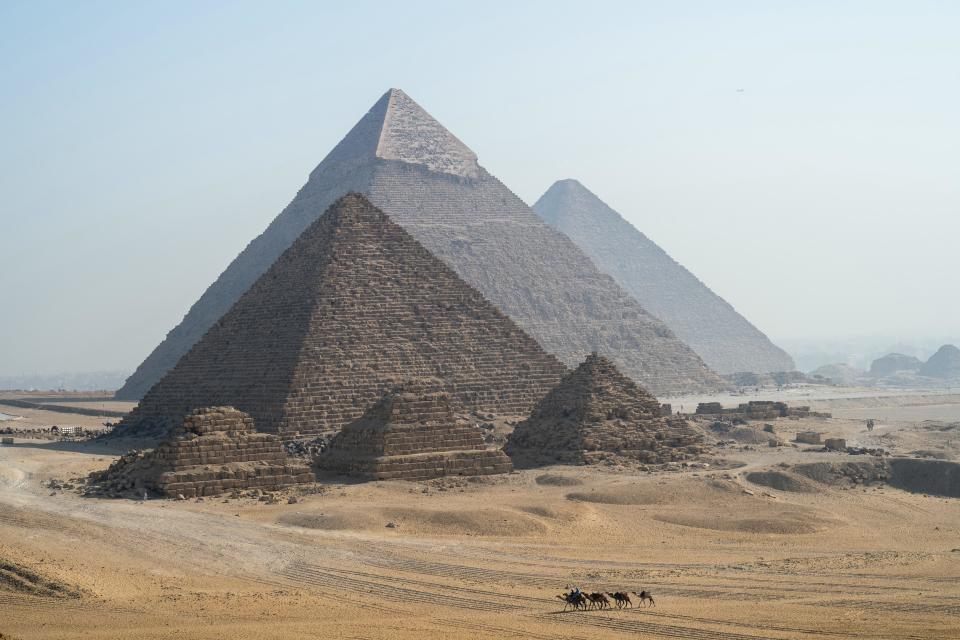Scientists have discovered a long-buried tributary of the Nile river that once flowed next to more than 30 pyramids in Egypt, potentially solving the mystery of how ancient Egyptians transported huge blocks of stone to build famous monuments.
The 40-mile-long tributary, which runs past the iconic Giza pyramid complex among other wonders, was hidden under desert and farmland for millennia, according to a study that revealed the find Thursday.
The presence of the river may explain why 31 pyramids were built in a chain across a now inhospitable strip of desert in the Nile Valley between 4,700 and 3,700 years ago.
The strip near Ancient Egypt’s capital, Memphis, contains the Great Pyramid of Giza, the only surviving structure of the seven wonders of the ancient world, as well as the pyramids of Khafre, Cheops and Mykerinos.
Archaeologists have long thought that ancient Egyptians must have used a nearby waterway to transport the huge materials used to build the pyramids.
“But no one was sure of the location, shape, size or proximity of this mega waterway to the site of the pyramids,” study lead author Eman Ghoneim, from the University of North Carolina Wilmington in the United States, told AFP.

The international research team used radar satellite images to map the tributary they named Ahramat, meaning “pyramids” in Arabic.
The radar gives them “the unique ability to penetrate the sand surface and produce images of hidden features, including buried rivers and ancient structures,” Ghoneim said.
Field studies and sediment cores from the area confirmed the existence of the river, according to research in the journal Communications Earth & Environment.
Scientists have suggested that the once-mighty river was increasingly covered with sand, possibly beginning during a major drought around 4,200 years ago.
“It is easier to swim in the river”
The pyramids of Giza stood on a plateau about a kilometer from the bank of the river.
Many of the pyramids had a “ceremonial elevated walkway” that ran along the river and ended at the Valley Temples, which served as a port, Ghoneim said.
This suggests that the river “played an important role in transporting the massive construction materials and workers required to build the pyramid,” he added.
Exactly how the ancient Egyptians were able to build such large and long-standing structures has been one of history’s greatest mysteries.
These heavy materials, mostly from the south, “will be much easier to transport by floating on the river than by land,” study co-author Suzanne Onstine of the University of Memphis told AFP.
He suggested that the river banks may have been where the pharaohs’ funerary entourage were received before their bodies were carried “to the final burial place within the pyramid.”
The river may also show why the pyramids were built at different points.
“The flow and volume of water changed over time, so the fourth dynasty kings had to make different choices than the 12th dynasty kings,” he said.
“This discovery reminded me of the close connection between geography, climate, environment and human behavior.”
The study follows recent research projects focusing on the iconic pyramids.
Earlier this year, archaeologists launched an investigation. big projectRestoring the smallest of Giza’s three famous pyramids as they believe it was built more than 4,000 years ago. An Egyptian-Japanese archaeological mission has announced a project to relocate hundreds of granite blocks that form the outer covering of the pyramid of King Menkaure.
However, some archaeologists, including the former head of Egypt’s Ministry of Antiquities, did not agree with the project and expressed concerns as the excavations continued. Dr. is the former Director of the Egyptian Antiquities Sector and a former senior official in the Egyptian Ministry of Antiquities. Mohamed Abd El-Maqsoud told CBS News that before the granite blocks were moved, they had to be thoroughly inspected to verify that they were all in equal pieces. To start with, structure.
Last year, a team of archaeologists and other scientists in Egypt used cutting-edge technology based on beams of radiation from space to get a clear picture of a 30-foot-tall rock. Corridor inside the Great Pyramid of GizaThe place is hidden behind the main entrance of the ancient building.
Ahmed Shawkat contributed to this report.
A woman who ignored warnings was attacked by a bull on the Mexican beach
Pope Francis blessed same-sex couples
Morehouse College prepares for possible disruptions ahead of Biden’s commencement speech